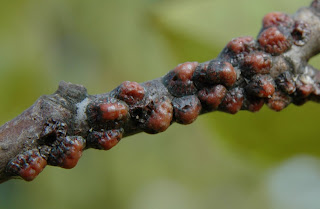Yellow spotting or banding caused by Cryptomeria scale.

Ants attracted to the honeydew produced by Tuliptree scale (soft scale).

Magnolia scales on Star magnolia (notice the scale in the upper right corner has been chewed open by a beneficial insect–probably a lady beetle).
Holly infested with white prunicola scale. All photos provided by: Brian Kunkel, Ornamentals IPM Specialist, University of Delaware.
Tag Archives: August
Insect Hotline Issue 18

Fungus gnats (maggots). Photo provided by: David Cappaert, Michigan State University, Bugwood.org
Japanese beetle white grub. Photo provided by: Mike Reding & Betsy Anderson, USDA Agricultural Research Service, Bugwood.org
Count the five prolegs (fleshy appendages) on the black swallowtail caterpillar. Photo provided by: Brian Kunkel, Ornamentals IPM Specialist, University of Delaware
Notice the eight prolegs (fleshy appendages) on the redheaded pine sawfly. Photo by: G. Keith Douce, University of Georgia, Bugwood.org.
Insect Hotline Issue 22
Disease Hotline Issue 22
Disease Hotline Issue 21

Horse chestnut leaf blotch. Photo by: M. Petitjean, University of Massachusetts Extension & found at: http://www.umassgreeninfo.org/fact_sheets/diseases/guignardia_leaf_blotch.pdf
Oak infested with oak anthracnose. Photo provided by: Joseph O’Brien, USDA Forest Service, Bugwood.org
Oak anthracnose on oak leaf. Photo provided by: Joseph O’Brien, USDA Forest Service, Bugwood.org
Close-up of oak anthracnose. Photo provided by: Robert L. Anderson, USDA Forest Service, Bugwood.org
Bacterial leaf scorch. Photo provided by: Randy Cyr, Greentree, Bugwood.org
Glassy-winged sharpshooter vectors Xylella fastidiosa in grape plants, the same bacteria responsible for BLS. A possible vector. Photo provided by: Reyes Garcia III, USDA Agricultural Research Service, Bugwood.org
Grass sharpshooter is also known to vector X. fastidiosa in grape plants. Another potential vector for BLS. Photo provided by: Jack Clark, University of California – Davis, Bugwood.org



